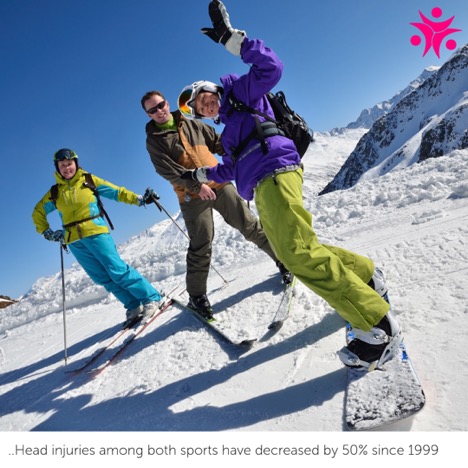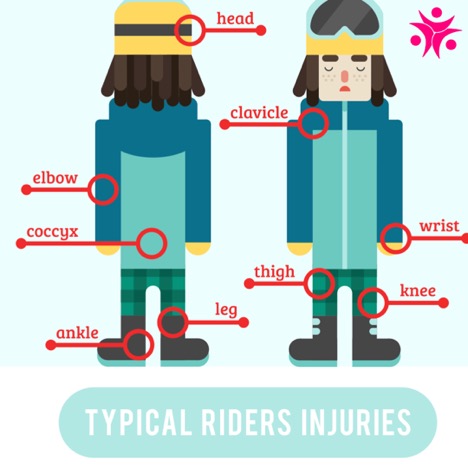Make an Appointment
f you’ve ever taken a holiday to the snowy mountains, you’ll have noticed the intense animosity between snowboarders and skiers. They famously aren’t fans of one another. Now, new studies have shown that one snow sport is more dangerous than the other, making their differences even more pronounced.
So, here we’ll be exploring skiing vs snowboarding injury statistics, what the most common skiing and snowboarding injuries are, and how to prevent them if you’re a regular on the slopes.
Skiing vs Snowboarding Injury Statistics Globally
There are a few global statistics to look at here.
The first is brought to you by the National Ski Areas Association in the US claiming that
“snowboarders are 50% to 70% more likely to get injured but they’re also a third less likely to be killed on a mountain than skiers.”

Potential reasons for these statistics include more safety measures for skiers since the 1970s. Since then, broken legs from skiing has become almost non-existent after skis were updated to come off at more appropriate times during a crash.
As for snowboards, they don’t come off during a crash. The edge of the board acts an immediate break in the snow which often leads to fractures. Hence, more injuries.
When it comes to actual fatalities at the hands of skiing, some professionals see a few reasons how these statistics could be true. First of all, if you can walk, you can ski – which means that often, skiers are far less skilled than snowboarders in terms of breaking and steering.
Additionally, skiing is all about racing while snowboarding is all about tricks and maneuvers. Most ski deaths, according to the research, were attributed to collisions with fixed objects at a high speed. That would make sense if people were often hurdling down mountains as fast as they could on skis. Attempting dangerous tricks would also explain why snowboarding injuries happen more often.
The same study also found that head injuries among both sports have decreased by 50% since 1999, which is being attributed to the increased use of helmets on the slopes.
Skiing vs Snowboard Injury Statistics in Australia
Sports Medicine Australia conducted a study over three years that explored snowboarding and skiing injuries in Victoria. The findings showed that between the years 2004 and 2007, 383 skiers were admitted to hospital.
In a similar study, between 2003 and 2004, only a one-year period, 384 snowboarders were admitted to hospital. This seems to be consistent with the US study claiming that snowboarders get injured more often than skiers.
The majority of these patients, both for skiing and snowboarding, were males between the ages of 15 and 34. Often, these injuries would occur from falls or being hit by another person with a variety of ailments like limb fractures, head injuries, and sometimes injuries to internal organs.
Most Common Injuries

Knee Injuries
For skiers especially, knee injuries are incredibly common. Skiing involves more twisting and turning at the knee joint which can lead to these painful knee injuries that express themselves with a popping sound.
- Anterior and Posterior Cruciate Ligament (ACL/PCL) Injuries: These stabalising ligaments within the knee can be injured with a sudden twist at the knees while the feet are planted. If the ACL is torn completely, surgery may be necessary. Check out our article on ACL Injury treatment options
- Meniscus Injuries: Meniscus is the cartilage in your knee that allows for smooth movement and sudden twisting motions can cause it to tear. Large tears may require surgery.
Head, Neck, and Shoulder Injuries
Head, neck, and shoulder injuries often occur as a result of falls, which are common in winter sports.
- Concussions: Occurs when your brain hits your skull. Any blow to the head should be handles with care and intently monitored.
- Whiplash: A hyperextension injury caused by sudden stops.
- Neck Strain: Sometimes associated with whiplash but may take a few days to show signs.
- Shoulder (Clavicle) Fracture: A broken collarbone that can be caused by a fall
- Rotator Cuff Tear: Shoulder injury associated with repetitive strain or caused by a fall
- Shoulder Separation: Occurs when falling on an outstretched hand. Can be treated with ice, rest, and support.
- Shoulder Dislocation: When the shoulder joint comes out of its socket. Requires reduction and sometimes surgery.
Hand and Wrist Injuries
Yes, even your hands are at risk of becoming injured when skiing or snowboarding.
- Skier’s Thumb: Occurs when you fall on your hand while still holding a ski pole. Your thumb ligament can tear which results in difficulty grasping. May require surgery.
- Wrist Sprains: Extreme strain of the wrist joint as a result of a fall which can be treated by a physio
- Finger Fractures: Breaking your finger bones from falling. Might call for reduction, a splint, or surgery.
Other potential injuries associated with winter sports include:
- Lower back pain
- Herniated disks
- Frostbite and hypothermia
- Delayed-Onset Muscle Soreness
Prevention Strategies
Even though there is a chance you’ll get injured while skiing or snowboarding, that’s no reason to cancel your winter holiday. Instead, use some of these prevention tips when hitting the mountain.
Injury prevention strategies for snowboarders:
- Wear impact shorts. These shorts look like padded underwear that help snowboarders absorb falls.
- Wear wrist guards. These guards spread the impact shock and help to prevent broken bones.
Injury prevention strategies for skiers:
- Make sure your ski binding’s DIN release mechanism is set correctly. This can prevent lower leg bone, ligament, and tendon damage in the event of a crash.
- Use shorter skis. They can lower the leverage on your legs and help to prevent tibia and fibia fractures as well as other ankle injuries.
There’s always an inherent risk when you go skiing or snowboarding. Those with less experience are always the most vulnerable, so do your best to prepare in advance. In general, injury prevention for anyone holidaying on the slopes are as follows:
- Take lessons and stick with your appropriate skill level.
- Complete pre-season conditioning programs with a physiotherapist.
- Only ski or snowboard in good snow conditions.
- Seek professional advice when hiring or buying equipment to make sure it fits properly and is appropriate for your skill level.
- Always wear a helmet. As one of your most important pieces of safety equipment, modern snowboarding and ski helmets are lightweight and provide excellent protection.
- Warm up. Even a simple five minute warm up can properly prepare your body and prevent injuries.
Have you been injured while skiing or snowboarding in Australia or New Zealand? We’re so sorry to hear that things went awry. Our expert physiotherapists at Physio Inq are here to help.
Give us a call now and set up an appointment. With our mobile services, we can even come to you! We’ll get you back on your feet and ready for your next winter holiday.
Date Published: Tuesday, July 21, 2020
Need to get into direct contact with ur Client Services team? We're all ears. Call our team directly on 1300 731 733
